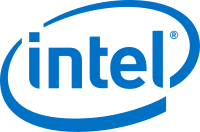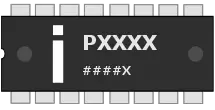From WikiChip
Difference between revisions of "intel"
(→Processor Families) |
|||
| Line 18: | Line 18: | ||
}} | }} | ||
'''Intel Corporation''' is an American [[semiconductor]] company. While most notably known for their development of [[microprocessors]] and [[x86]], Intel also designs and manufactures other [[integrated circuit]]s including [[flash memory]], [[network interface controller]]s, [[GPU]]s, [[chipset]]s, motherboards, and computers. | '''Intel Corporation''' is an American [[semiconductor]] company. While most notably known for their development of [[microprocessors]] and [[x86]], Intel also designs and manufactures other [[integrated circuit]]s including [[flash memory]], [[network interface controller]]s, [[GPU]]s, [[chipset]]s, motherboards, and computers. | ||
| + | |||
| + | In addition to [[x86]], Intel used to also design and manufacture [[ARM]]-based chips as well as embed [[ARC]]-based cores in their products. While they no longer sell such chips, they still use ARM processors in various products (e.g. in their FPGAs) as well as still retain full a architectural level ARM license allowing them to design and sell their own ARM devices should they wish to. | ||
== Find Chip == | == Find Chip == | ||
| Line 84: | Line 86: | ||
* {{intel|Pentium MMX}} | * {{intel|Pentium MMX}} | ||
* {{intel|Pentium Pro}} | * {{intel|Pentium Pro}} | ||
| + | * {{intel|PXA}} | ||
* {{intel|Quark}} | * {{intel|Quark}} | ||
* {{intel|Xeon}} | * {{intel|Xeon}} | ||
| Line 104: | Line 107: | ||
== Microarchitectures == | == Microarchitectures == | ||
| − | '''Mainstream:''' | + | '''Mainstream ([[x86]]):''' |
{{collist | {{collist | ||
| count = 4 | | count = 4 | ||
| Line 130: | Line 133: | ||
* {{intel|Tigerlake|l=arch}} | * {{intel|Tigerlake|l=arch}} | ||
}} | }} | ||
| − | ''' | + | '''ULP ([[x86]]):''' |
{{collist | {{collist | ||
| count = 2 | | count = 2 | ||
| − | |||
| | | | ||
* {{intel|Bonnell|l=arch}} | * {{intel|Bonnell|l=arch}} | ||
| Line 140: | Line 142: | ||
* {{intel|Airmont|l=arch}} | * {{intel|Airmont|l=arch}} | ||
* {{intel|Goldmont|l=arch}} | * {{intel|Goldmont|l=arch}} | ||
| + | }} | ||
| + | '''ULP ([[ARM]]):''' | ||
| + | {{collist | ||
| + | | count = 3 | ||
| + | | | ||
| + | * {{intel|XScale|l=arch}} | ||
| + | * {{intel|XScale 2|l=arch}} | ||
| + | * {{intel|XScale 3|l=arch}} | ||
| + | * {{intel|Mohawk|l=arch}} | ||
| + | * Continued by [[Marvell]] .. | ||
| + | }} | ||
| + | '''Server (EPIC) ([[Itanium]]):''' | ||
| + | {{collist | ||
| + | | count = 4 | ||
| + | | | ||
| + | * {{intel|Merced|l=arch}} | ||
| + | * {{intel|McKinley|l=arch}} | ||
| + | * {{intel|Madison|l=arch}} | ||
| + | * {{intel|Deerfield|l=arch}} | ||
| + | * {{intel|Hondo|l=arch}} | ||
| + | * {{intel|Madison 9M|l=arch}} | ||
| + | * {{intel|Fanwood|l=arch}} | ||
| + | * {{intel|Montecito|l=arch}} | ||
| + | * {{intel|Chivano|l=arch}} | ||
| + | * {{intel|Millington|l=arch}} | ||
| + | * {{intel|Montvale|l=arch}} | ||
| + | * {{intel|Tukwila|l=arch}} | ||
| + | * {{intel|Dimona|l=arch}} | ||
| + | * {{intel|Poulson|l=arch}} | ||
| + | * {{intel|Kittson|l=arch}} | ||
}} | }} | ||
'''Other:''' | '''Other:''' | ||
| + | {{collist | ||
| + | | count = 1 | ||
| + | | | ||
* {{intel|Larrabee}} | * {{intel|Larrabee}} | ||
| + | }} | ||
'''GPU:''' | '''GPU:''' | ||
{{collist | {{collist | ||
Revision as of 05:32, 28 May 2017
| Intel | |||||||||

| |||||||||
| Type | Public | ||||||||
| Founded | July 18, 1968 Mountain View, California | ||||||||
| Founder | Gordon Moore Robert Noyce Andrew Grove | ||||||||
| Headquarters | Santa Clara, California | ||||||||
| Website | http://www.intel.com | ||||||||
| |||||||||
Intel Corporation is an American semiconductor company. While most notably known for their development of microprocessors and x86, Intel also designs and manufactures other integrated circuits including flash memory, network interface controllers, GPUs, chipsets, motherboards, and computers.
In addition to x86, Intel used to also design and manufacture ARM-based chips as well as embed ARC-based cores in their products. While they no longer sell such chips, they still use ARM processors in various products (e.g. in their FPGAs) as well as still retain full a architectural level ARM license allowing them to design and sell their own ARM devices should they wish to.
Contents
Find Chip
- By S-Spec
Processor Families
- 3000
- 80186
- 80188
- 80286
- 80376
- 80386
- 80486
- Atom
- Atom x3
- Atom x5
- Atom x7
- Celeron
- Celeron D
- Celeron M
- Core 2 Duo
- Core 2 Extreme
- Core 2 Quad
- Core 2 Quad Extreme
- Core 2 Solo
- Core Duo
- Core i3
- Core i5
- Core i7
- Core i7 EE
- Core M
- Core Solo
- EP80579
- i860
- i960
- iAPX432
- Itanium
- Itanium 2
- MCS-4
- MCS-40
- MCS-48
- MCS-51
- MCS-8
- MCS-80
- MCS-85
- MCS-86
- MCS-88
- MCS-96
- Mobile Pentium II
- Pentium
- Pentium 4
- Pentium 4 EE
- Pentium 4-M
- Pentium D
- Pentium EE
- Pentium II
- Pentium III
- Pentium III Mobile
- Pentium III Xeon
- Pentium II Mobile
- Pentium II Xeon
- Pentium M
- Pentium MMX
- Pentium Pro
- PXA
- Quark
- Xeon
- Xeon Bronze
- Xeon D
- Xeon E3
- Xeon E5
- Xeon E7
- Xeon Gold
- Xeon Platinum
- Xeon Silver
Instruction set architectures
Microarchitectures
Mainstream (x86):
ULP (x86):
ULP (ARM):
Server (EPIC) (Itanium):
Other:
GPU:
Other Chips
Other
Other topics
Facts about "Intel"
| company type | public + |
| founded | July 18, 1968 + |
| founded location | Mountain View, California + |
| founder | Gordon Moore +, Robert Noyce + and Andrew Grove + |
| full page name | intel + |
| headquarters | Santa Clara, California + |
| instance of | semiconductor company + |
| name | Intel + |
| website | http://www.intel.com + |
| wikidata id | Q248 + |

